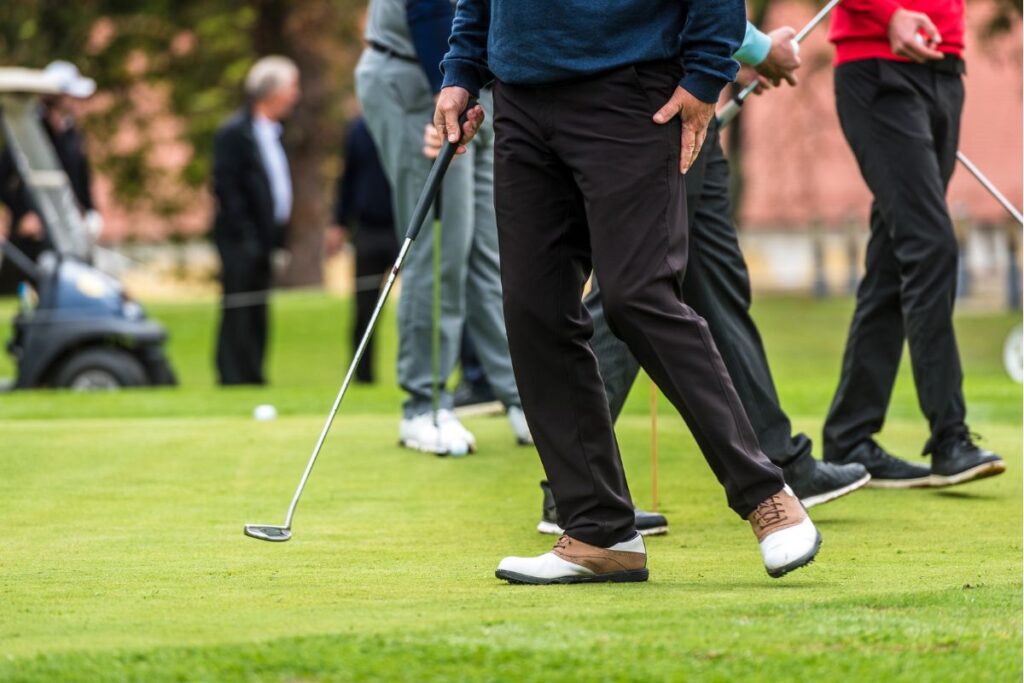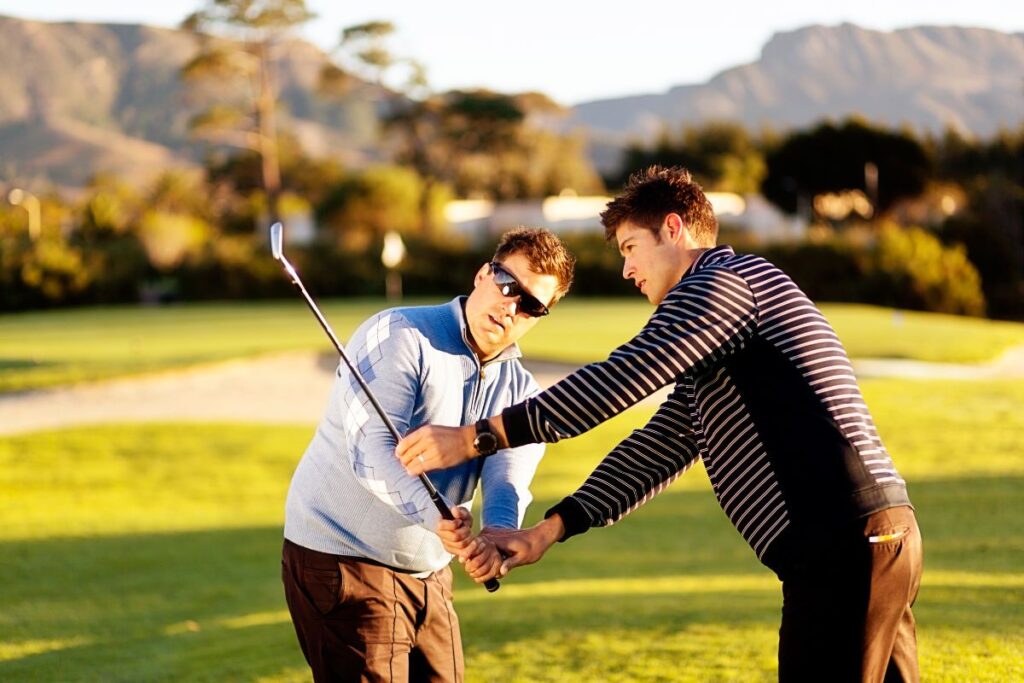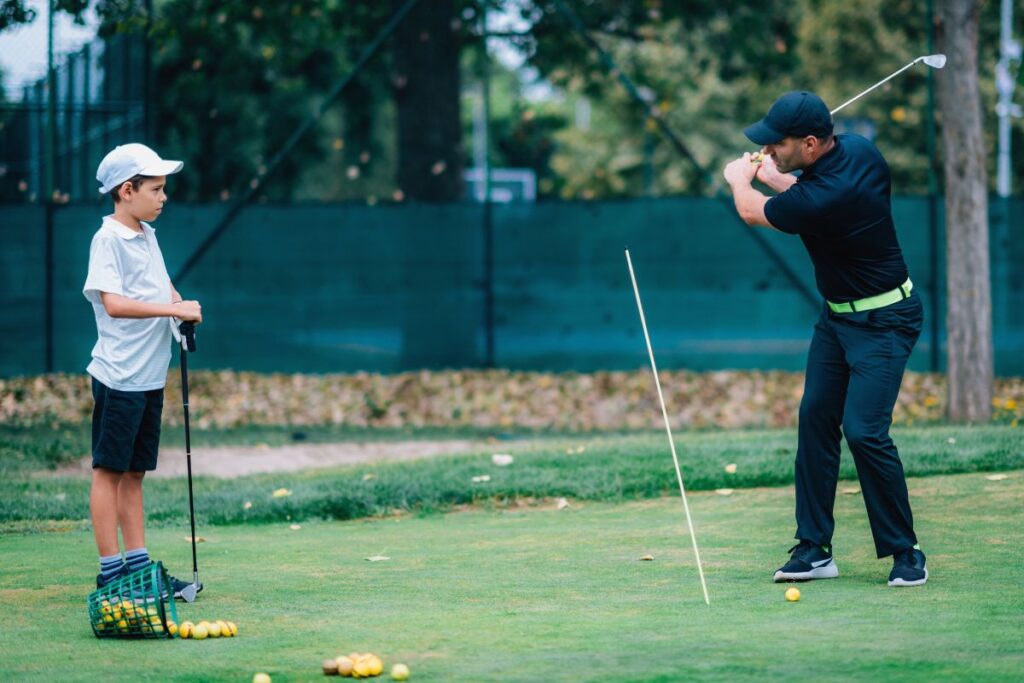Wondering about golf? Let’s talk about whether your left leg should be straight when you hit the ball. We’ll explore how it affects your swing and shots to find out if it really makes a difference for a better game.
Table of Contents
Locking Up The Front Knee
The golf swing mistake called “locking up the front knee” happens when you slowly make your left leg straighter as you swing down. You can see this error when, at the moment of hitting the ball, your left leg looks totally straight with no bend in the knee. This is not good. A better swing keeps a bit of bend in the left knee when hitting the ball.
In simple terms, the little bend you have in your knees when you start should stay mostly the same during your swing, at least until you hit the ball. Only after hitting the ball, when you’re finishing your swing, should your weight be mostly on your left foot and your left leg straight.
Issues Related to Straightening Your Leading Knee
The main issue when your left knee loses its bend during impact is that it messes up how your hips move.
Normally, your hips are supposed to twist without moving too much to the sides. But if you straighten your left leg as you’re about to hit the ball, your hips will be pulled toward that left leg. This also causes your hips to turn more to the left.
Because of this, it becomes hard to avoid swinging the club from outside to inside, which leads to shots that tend to curve from left to right.
While this isn’t a major problem on its own, having an outside-in club path makes it tricky to hit shots that go straight to the target.
Preventing Your Leading Knee from Locking at Impact
Stopping your left knee from getting straight when you hit the ball might be a bit harder than stopping your right knee from getting straight at the top of your swing, but you should still try to do it. One good way to help with this is by paying attention to your head, which can show you if your leg is doing the right thing.
If you try to keep your head from moving too much – like keeping it still in the air, both up and down and side to side – you’ll have a better chance of keeping your left knee a little bent during your whole swing.
This works because if you make your left leg straight, it will push your hips up, which will then make your head go up too. But if you focus on keeping your head in one place, your hips will probably stay at the same height, and this can help you keep your knees from locking.
So, if you pay attention to your head, you can improve how your legs work and how you hit the ball.
Should I lock my trailing knee?
The right knee might stiffen when you reach the top of your backswing, and a similar thing can happen with the left knee at impact. You should try to avoid both of these mistakes in your swing – locking your right knee at the top and locking your left knee when you hit the ball.
Benefits of Keeping Flex In The Knees
Maintaining a consistent bend in your knees, from the setup to the moment of impact, promotes a swing path that goes inside, then square, and inside again. Unlike locking up either knee, this approach keeps your hip and shoulder angles unchanged, helping you stay on track with this desirable swing path.
If you lock your right knee during the backswing, your hips and shoulders turn a lot to the right. This makes your swing go inside, and it’s hard not to hit the ball to the right.
Similarly, if you lock your left knee when bringing the club down, your hips and shoulders turn a lot to the left. This makes your swing go outside, and it’s hard not to hit the ball to the left.
To hit better shots, keep your knees flexible and avoid locking them.
Your hips and shoulders are supposed to turn slowly to the right on the backswing and then to the left on the downswing. If you lock one knee or the other, it messes up the position of your hips and shoulders, making it hard to avoid swinging the club too much from the inside or outside.
By keeping the knee bend the same, you help yourself stay on track with a good swing path that goes inside, then square, and inside again.
Using Your Legs To Play Better Golf – Arnold Palmer’s Strategy
1. Raise your left heel
Arnold Palmer had become a master of the often-debated action of raising the left foot. Usually, when I observe non-professionals lifting their left heel during the backswing, it tends to cause excessive sideways movement of the head and chest. This can make it difficult to consistently connect with the ball.
Ultimately, there’s no problem with lifting your left heel if it aids in better hip and chest rotation during your backswing. Nonetheless, it’s crucial to maintain relatively steady head position over the ball; otherwise, you’ll likely encounter a variety of erratic shots.
2. Push down on your left heel
To start the downswing, Arnie pushed his left heel down. Remember, in Arnie’s swing, you should stomp or push your left heel into the ground as you begin the downswing, just like the top players who do this slightly before completing their backswing.
3. Power Squat
When he starts his downswing, his leg movement actually increases the space between them. It’s somewhat like a squatting motion.
You might have seen drills where a person swings back with a ball between their legs and drops it when they begin the downswing. This powerful technique keeps the body coordinated and leads to consistent, solid shots.
Final Thoughts
In conclusion, understanding and applying these key techniques can significantly enhance your golf swing. By maintaining flexibility in your knees, avoiding knee lock-ups, and incorporating precise foot movements, you can promote a more consistent and powerful swing path. Through dedicated practice and mindful execution, you can elevate your golf game to new heights. So, step onto the fairway with confidence, armed with the insights gained here, and watch as your performance improves, one swing at a time.



